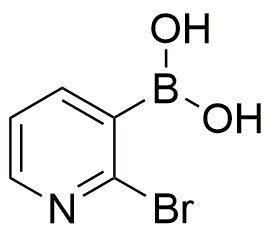2-Bromopyridine-3-boronic acid is widely utilized in research focused on:
- Synthetic Chemistry: This compound serves as a key intermediate in the synthesis of various pharmaceuticals and agrochemicals, enabling the development of new drugs and crop protection agents.
- Cross-Coupling Reactions: It is commonly used in Suzuki-Miyaura coupling reactions, which are essential for forming carbon-carbon bonds in organic synthesis, making it valuable for researchers in organic chemistry.
- Material Science: The compound can be utilized in the development of new materials, including polymers and nanomaterials, which are important for electronics and advanced manufacturing.
- Bioconjugation: Its boronic acid functionality allows for selective binding to diols, making it useful in bioconjugation applications for drug delivery systems and targeted therapies.
- Fluorescent Probes: Researchers leverage its properties to create fluorescent probes for biological imaging, enhancing the ability to visualize cellular processes in real-time.
General Information
Properties
Safety and Regulations
Applications
2-Bromopyridine-3-boronic acid is widely utilized in research focused on:
- Synthetic Chemistry: This compound serves as a key intermediate in the synthesis of various pharmaceuticals and agrochemicals, enabling the development of new drugs and crop protection agents.
- Cross-Coupling Reactions: It is commonly used in Suzuki-Miyaura coupling reactions, which are essential for forming carbon-carbon bonds in organic synthesis, making it valuable for researchers in organic chemistry.
- Material Science: The compound can be utilized in the development of new materials, including polymers and nanomaterials, which are important for electronics and advanced manufacturing.
- Bioconjugation: Its boronic acid functionality allows for selective binding to diols, making it useful in bioconjugation applications for drug delivery systems and targeted therapies.
- Fluorescent Probes: Researchers leverage its properties to create fluorescent probes for biological imaging, enhancing the ability to visualize cellular processes in real-time.
Documents
Safety Data Sheets (SDS)
The SDS provides comprehensive safety information on handling, storage, and disposal of the product.
Product Specification (PS)
The PS provides a comprehensive breakdown of the product’s properties, including chemical composition, physical state, purity, and storage requirements. It also details acceptable quality ranges and the product's intended applications.
Certificates of Analysis (COA)
Search for Certificates of Analysis (COA) by entering the products Lot Number. Lot and Batch Numbers can be found on a product’s label following the words ‘Lot’ or ‘Batch’.
Numéro de catalogue
Numéro de lot/série
Certificates Of Origin (COO)
This COO confirms the country where the product was manufactured, and also details the materials and components used in it and whether it is derived from natural, synthetic, or other specific sources. This certificate may be required for customs, trade, and regulatory compliance.
Numéro de catalogue
Numéro de lot/série
Safety Data Sheets (SDS)
The SDS provides comprehensive safety information on handling, storage, and disposal of the product.
DownloadProduct Specification (PS)
The PS provides a comprehensive breakdown of the product’s properties, including chemical composition, physical state, purity, and storage requirements. It also details acceptable quality ranges and the product's intended applications.
DownloadCertificates of Analysis (COA)
Search for Certificates of Analysis (COA) by entering the products Lot Number. Lot and Batch Numbers can be found on a product’s label following the words ‘Lot’ or ‘Batch’.
Numéro de catalogue
Numéro de lot/série
Certificates Of Origin (COO)
This COO confirms the country where the product was manufactured, and also details the materials and components used in it and whether it is derived from natural, synthetic, or other specific sources. This certificate may be required for customs, trade, and regulatory compliance.


